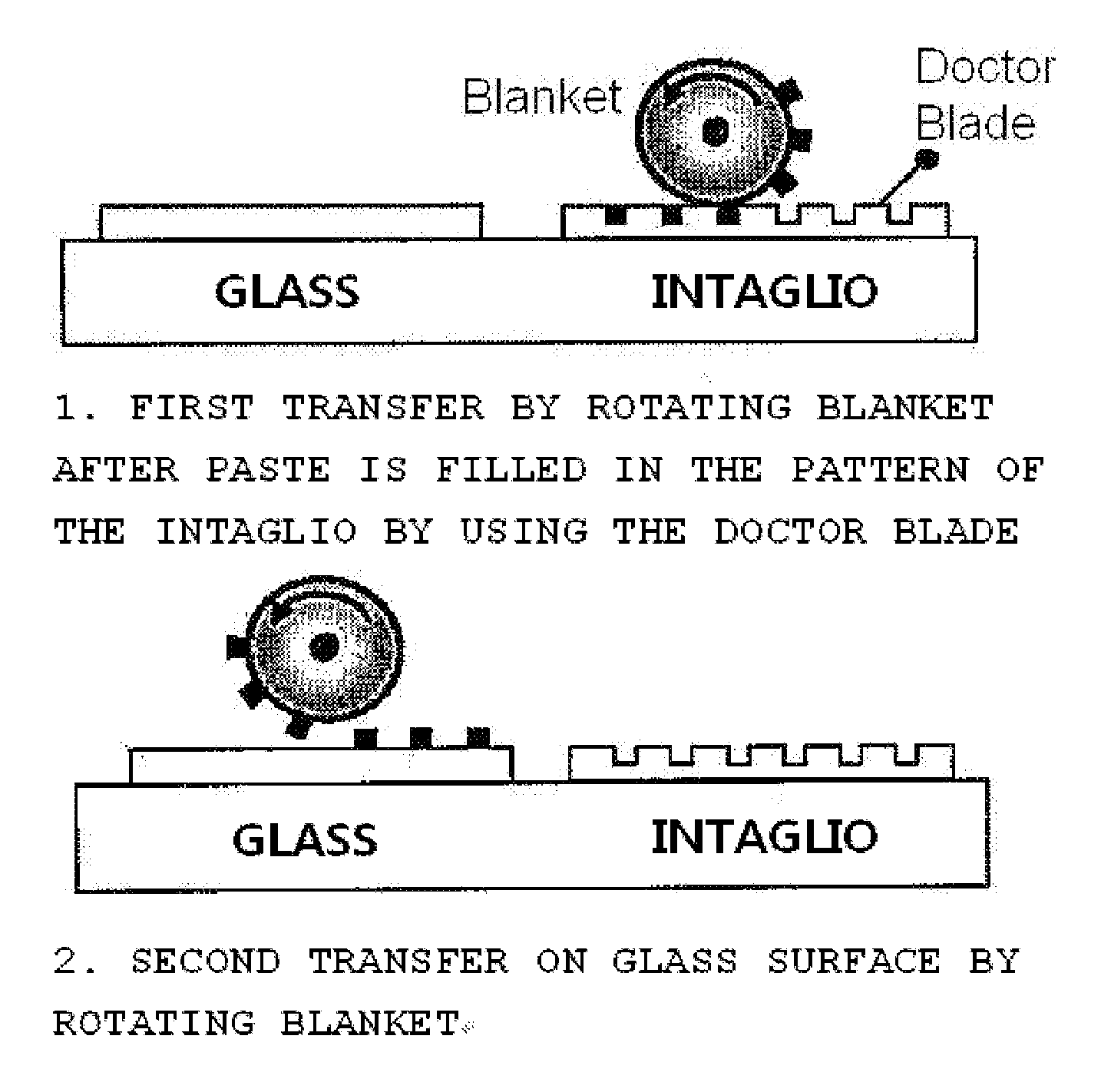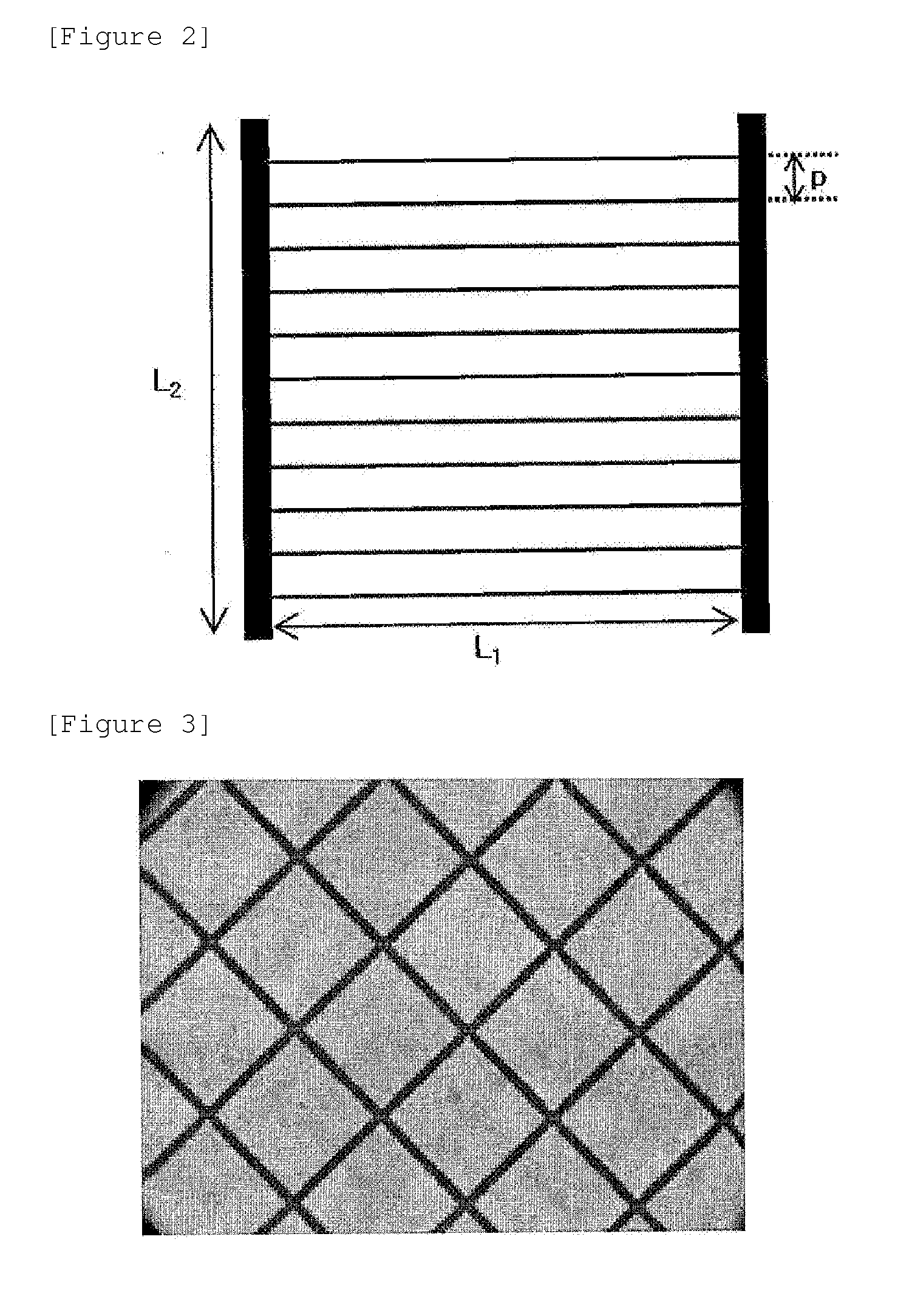Heating element and manufacturing method for same
a manufacturing method and heat dissipation technology, applied in the field of heat dissipation elements, can solve the problems of inability to manufacture products at low cost, inability to manufacture heating glass, and inability to drive at a low voltage of 40 v or less, and achieve excellent heating performance, low voltage, and low resistance.
- Summary
- Abstract
- Description
- Claims
- Application Information
AI Technical Summary
Benefits of technology
Problems solved by technology
Method used
Image
Examples
example 1
[0069]The silver paste was manufactured by dissolving 80% of silver particles of 2 micrometers, 5% of polyester resin, and 5% of grass frit in 10% BCA (Butyl carbitol acetate) solvent. As the intaglio, a glass that had patterns that had the interval of 300 micrometers, the width of 20 micrometers, and the depth of 7.5 micrometers and were orthogonally formed in a grid manner was used.
[0070]After the silver pattern of the grid manner was formed on the glass substrate (685 mm×400 mm) by using the method that was shown in FIG. 1 and the offset printer, it was sintered at 600° C. for 3 min to form the silver line shown in FIG. 3. In this case, the interval of the formed silver line was 300 micrometers, the line width was 20 micrometers, the line height was 1.5 micrometers, and the opening ratio was 84%. The surface resistance of the glass substrate was 0.4 ohm / square, and the bus bar was formed by contacting the copper strip on the pattern by the clip in the direction of 400 mm (FIG. 9)...
example 2
[0071]The silver paste was manufactured by dissolving 80% of silver particles of 2 micrometers, 5% of polyester resin, and 5% of grass frit in 10% BCA (Butyl carbitol acetate) solvent. As the intaglio, a glass that had patterns that had the interval of 300 micrometers, the width of 20 micrometers, and the depth of 7.5 micrometers and were orthogonally formed in a grid manner was used.
[0072]After the silver pattern of the grid manner was formed on the glass substrate (685 mm×400 mm) by using the manner shown in FIG. 1 and the offset printer, before the sintering, the semicircular portion that had the diameter of 10 cm at the lower portion of the pattern was cleaned. The silver line was formed by sintering the pattern for 3 min. In this case, the interval of the formed silver line was 300 micrometers, the width was 20 micrometers, the height was 1.5 micrometers, and the opening ratio was 84%. The surface resistance of the glass substrate was 0.4 ohm / square, and the bus bar was formed ...
example 3
[0075]The silver paste was manufactured by dissolving 77% of silver particles of 2 micrometers, 5% of polyester resin, 3% of grass frit, and 5% of cobalt oxides in 10% BCA (Butyl carbitol acetate) solvent. As the intaglio, a glass that had patterns that had the interval of 300 micrometers, the width of 20 micrometers, and the depth of 7.5 micrometers and were orthogonally formed in a grid manner was used.
[0076]After the silver pattern of the grid manner was formed on the glass substrate (685 mm×400 mm) by using the method that was shown in FIG. 1 and the offset printer, it was sintered at 600° C. for 3 min to form the silver line shown in FIG. 3. In this case, the interval of the formed silver line was 300 micrometers, the line width was 20 micrometers, the line height was 1.5 micrometers, and the opening ratio was 84%.
[0077]After the reflectivity (550 nm) of the conductive pattern was measured by using the UV-3600 that was manufactured by Shimadzu, Co., Ltd., the degree of blacknes...
PUM
| Property | Measurement | Unit |
|---|---|---|
| width | aaaaa | aaaaa |
| height | aaaaa | aaaaa |
| height | aaaaa | aaaaa |
Abstract
Description
Claims
Application Information
 Login to View More
Login to View More - R&D
- Intellectual Property
- Life Sciences
- Materials
- Tech Scout
- Unparalleled Data Quality
- Higher Quality Content
- 60% Fewer Hallucinations
Browse by: Latest US Patents, China's latest patents, Technical Efficacy Thesaurus, Application Domain, Technology Topic, Popular Technical Reports.
© 2025 PatSnap. All rights reserved.Legal|Privacy policy|Modern Slavery Act Transparency Statement|Sitemap|About US| Contact US: help@patsnap.com



